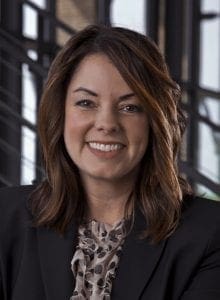By Bob Vajgrt and Christin Mlsna

Christin Mlsna
The COVID-19 pandemic has created many challenges and hardships; it has also presented a great opportunity to rethink how our learning institutions are designed and function. We have seen innovation in almost every aspect of our society and now is the time to innovate schools. Our goal should be to keep the post-March 2020 changes that have positively impacted students and staff while continuing to improve and evolve in other areas.
Eppstein Uhen Architects Inc. and J.H. Findorff & Son Inc. are proud to have a long history of planning, designing, and constructing public and private K-12 and higher educational facilities. EUA recently published a resource “Design Considerations for K-12 Facilities Post Pandemic” which has information related to learning spaces, building circulation, main office entrances, common spaces, restrooms and staff resource spaces (https://www.eua.com/about-us/whats-new/design-considerations-for-k12-facilities-post-pandemic/). Findorff has been providing construction services for several market sectors to prepare them for staff returning to buildings.
Here are seven steps that learning institutions may consider as they look to bring students and staff back to their facilities:
- Implement long-term, future-focused change
Today is a great time to rethink our industrial-age designed learning institutions that in most cases are still based on “cells and bells.” Ideas identified in EUA’s “Design Considerations for K-12 Facilities Post Pandemic” guide should be considered as long-term solutions. Other areas to reconsider are the ridged bell schedule, movement of teachers rather than students, and flexibility in how students direct their own learning. Imagine students being allowed to utilize a space that they feel comfortable and safe in, where they can do their best work and is not predicated on a specific timeframe set by a bell.
- Evaluate your Heating, Ventilation, and Air Conditioning (HVAC) systems and air filtration
Review your current air filters in your main HVAC equipment. Current recommendations indicate MERV 13 (Minimum Efficiency Reporting Value) filters as the minimum to capture airborne viruses and bacteria. It’s important to review the system in total before increasing your filter rating to avoid unintended issues due to increased air restriction.
Install an air cleaning device. There are several types available on the market depending on your needs and budget. These clean the air before it is circulated back into the space.

Bob Vajgrt
Review the amount of ventilation in your HVAC design. Many schools, healthcare facilities, and other building types have focused in on energy efficiency, so the amount of outside air may be reduced to code minimum. Now is a good time to increase air exchanges to get more fresh air into the buildings. Make sure the HVAC system is designed to handle increased outside air, especially in large load conditions (very hot and very cold weather).
- Update room capacity based on de-densified populations
The physical distancing recommendation of six feet has an impact on the number of occupants a space can accommodate. It is obvious that with an increase of area required per person, the capacity of a space will be reduced and therefore all spaces need to be considered for repurposing.
In order to understand a building’s capacity and the capacities of the spaces it contains, it’s important to perform a de-densified capacity study. This should include all typical learning spaces and those that may be considered support spaces.
- Gain learning spaces by repurposing
As mentioned above, now is the time to reconsider how best to utilize school facilities beyond our current mindset. Typically, spaces such as libraries, cafeterias, commons, small and large group rooms, music and makerspaces are underutilized. With the reduced capacity in typical learning classrooms and spaces, the other spaces now need to be considered for student learning on a regular basis. All areas of the facility should be added to your capacity study and it should be expected that libraries, cafeterias, common spaces, etc. are utilized at a much higher level than they are today.
- Assess high touch and heavy traffic areas
One of the more common, and easier to implement options is the installation of plexiglass partitions to segment reception areas, desks and other large and small-group spaces. However, there are a variety of other changes schools can explore to reduce the amount of traffic in spaces or limit the amount of contact:
- Swap out traditional faucets and hand towel dispensers with sensor equipment
- Install hands-free, foot-pull door openers that are ADA compatible
- Add sanitizing stations at room entrances
- Change nonfunctioning or non-required drinking fountains with sinks
- Install automatic door operators at heavy traffic areas
- Review educational efficacy of learning spaces
An important part of evaluating learning spaces is to consider how best they support the program or the pedagogy that is being delivered in that space. Ensuring that the learning space supports the program or pedagogy will better support students and teachers. Sometimes changing the furniture is the only adjustment needed.
An Educational Adequacy Assessment (EAA) may be completed; the assessment comprehensively reviews program activities, use of the building, and physical spaces required for each activity and provides analysis of how effectively the spaces support student learning and program delivery. Six criteria are analyzed during this assessment:
- Safety & Security
- Size & Proportion
- Space Type & Adjacency
- Equipment & Infrastructure
- Furniture
- Environment
- Consider different learning modalities and pedagogies
Rethinking how we ‘do’ school requires a complete rethinking of learning and teaching and how we use space. We need to unlearn what we have done for over a century. School should provide for what cannot be done at home or online. As an example, the concept of a flipped classroom can allow for a better use of space for students and teachers; the strategy is a learner-centered model with a combination of online and in-class lectures, lessons, mentoring and activities instead of the traditional model of teaching in a classroom.
In our current COVID-19 environment, it’s even more important to continue to learn and improve so that our facilities can support the students, staff and communities in ways that they may not have pre-pandemic. We look forward to the discussions and changes that will make our educational facilities come out stronger after COVID-19.
Vajgrt is senior project manager, K12 project manager and principal for EUA. Mlsna is director of Education Market & Communication Services at J.H. Findorff & Son Inc.



